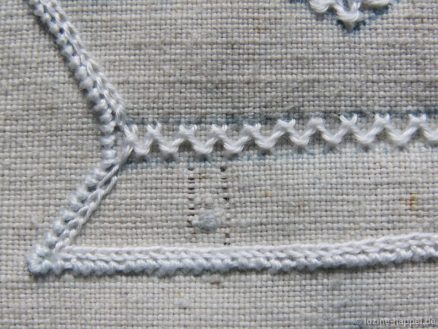Hand-woven linens often have a number of small defects. Most of them can be ignored.
However, if it is a fault that would spoil the overall impression, you should find a way to cover it up.
I found a clear fault in the form of a strong thread thickening – albeit without a knot – in the lower area of the basket motif of the Sofa Cushion 3 .
First of all, I tried to pull some of the fibers to the back using the tip of a needle and pluck them off from there.
However, this was only possible to a limited extent; the thread thickening was still so strong that it would have had a disruptive effect on the uniformity of many filling patterns. So a filling pattern had to be found that covered the defect.
I decided to use wide Satin stitch bars, counted the vertical fabric threads starting from the center longitudinal axis (24 threads to the fault) and then set the width of the Satin stitches to 5 fabric threads. As a precaution, I did not start pulling out the thread in the middle of the motif, but rather to the left and right of the fault area.
From there, further thread withdrawing was madet for a simple 5:1 withdrawn thread pattern. The thread withdrawing was continued above the row of interlaced Herringbone stitches.
The damaged area was embroidered over
and after washing it is only visible to those who know where the fault was.









je suis admiratif, j’ai un penchant pour les différents remplissage.
Bruno raine
Cela tombe bien, car le travail du la broderie de Schwalm propose une très large gamme de motifs de remplissage différents.